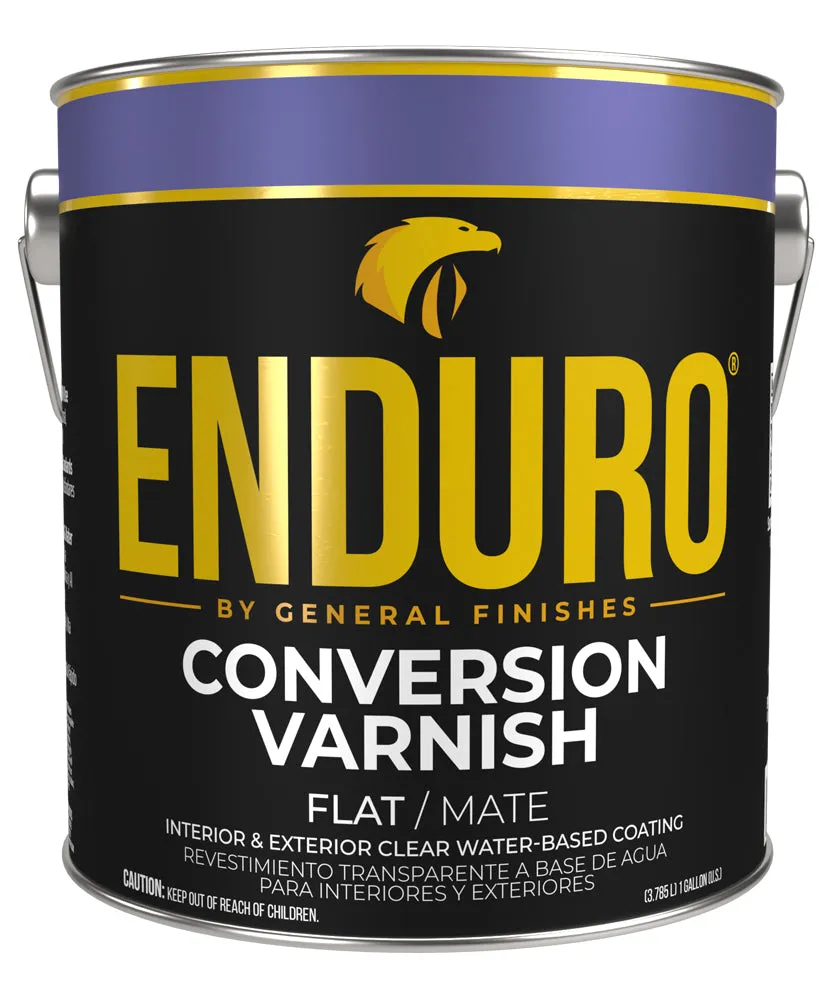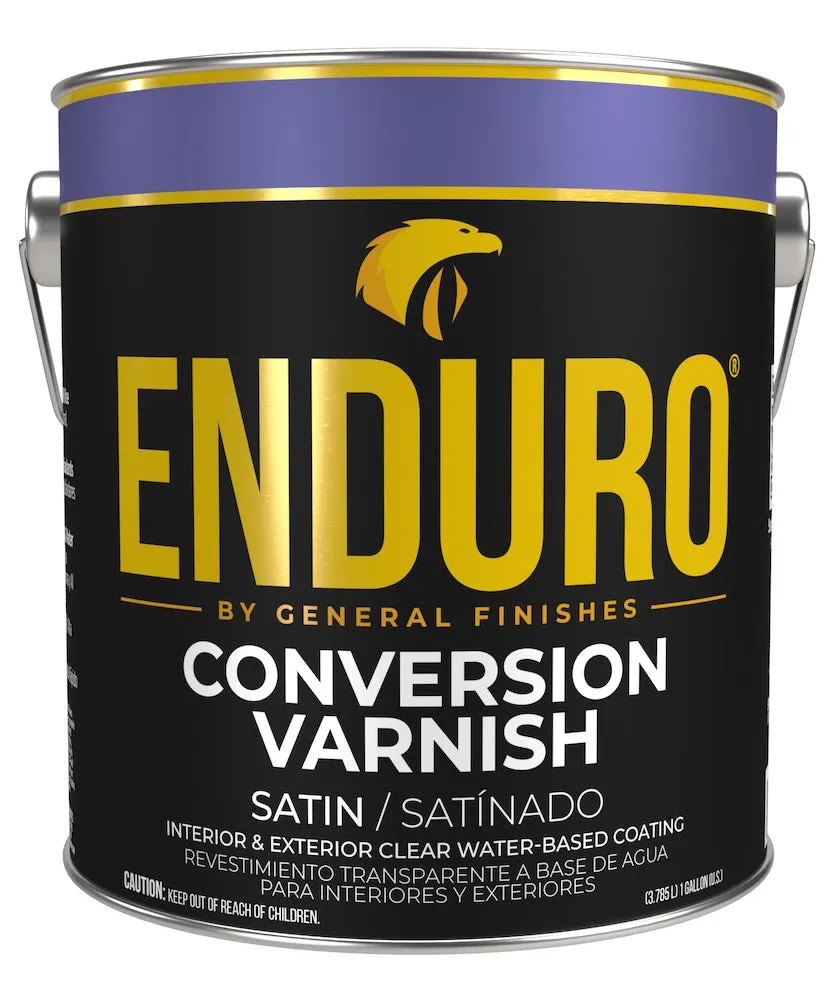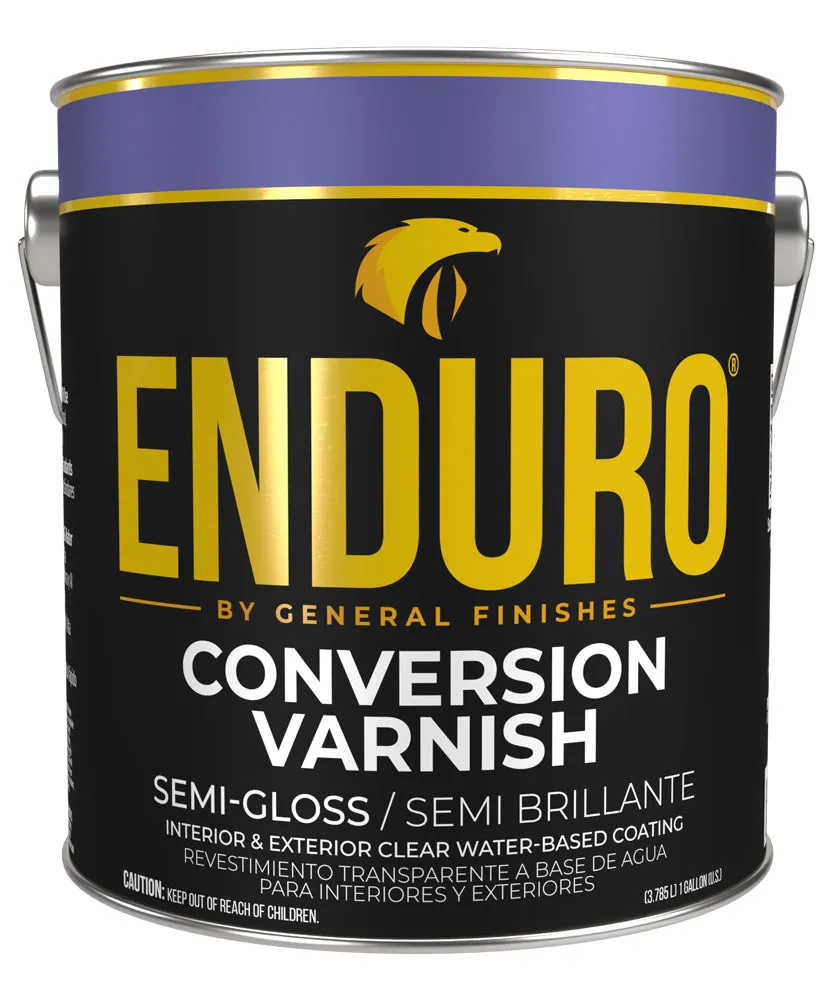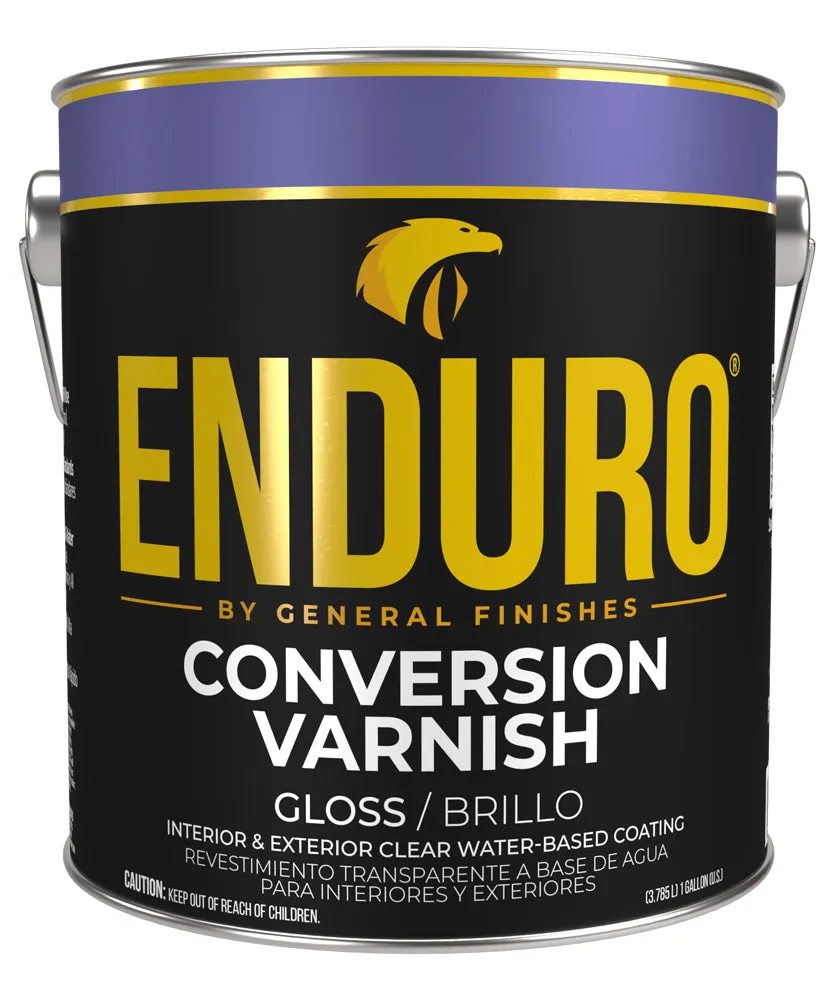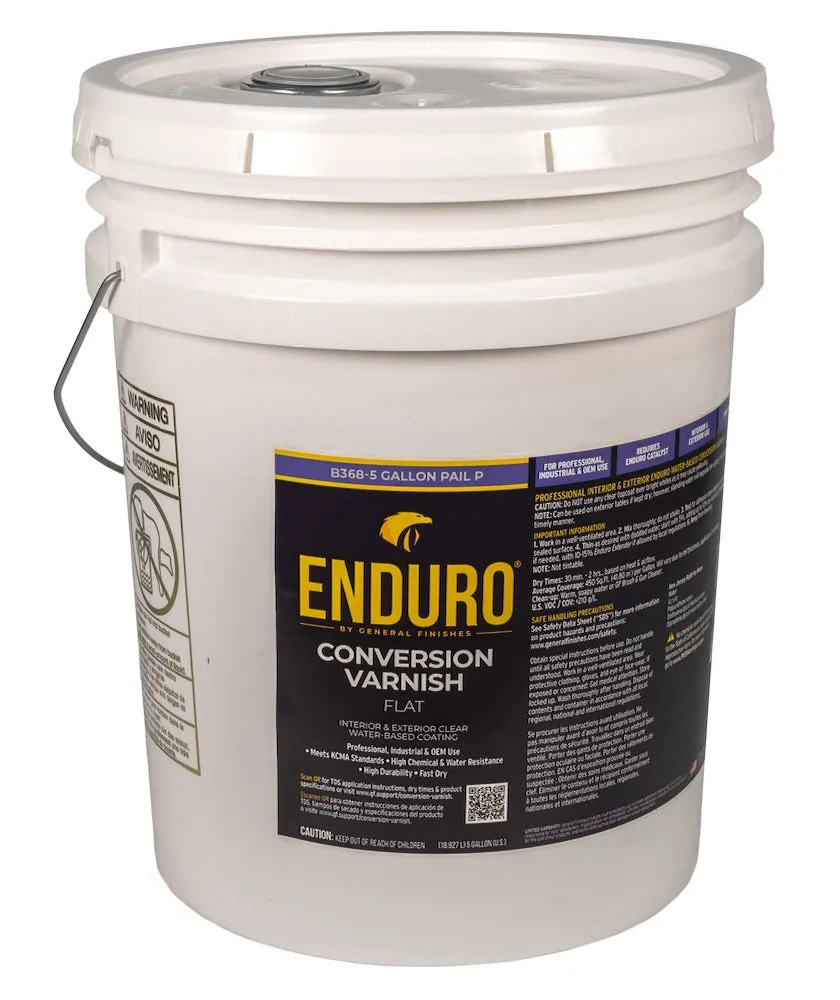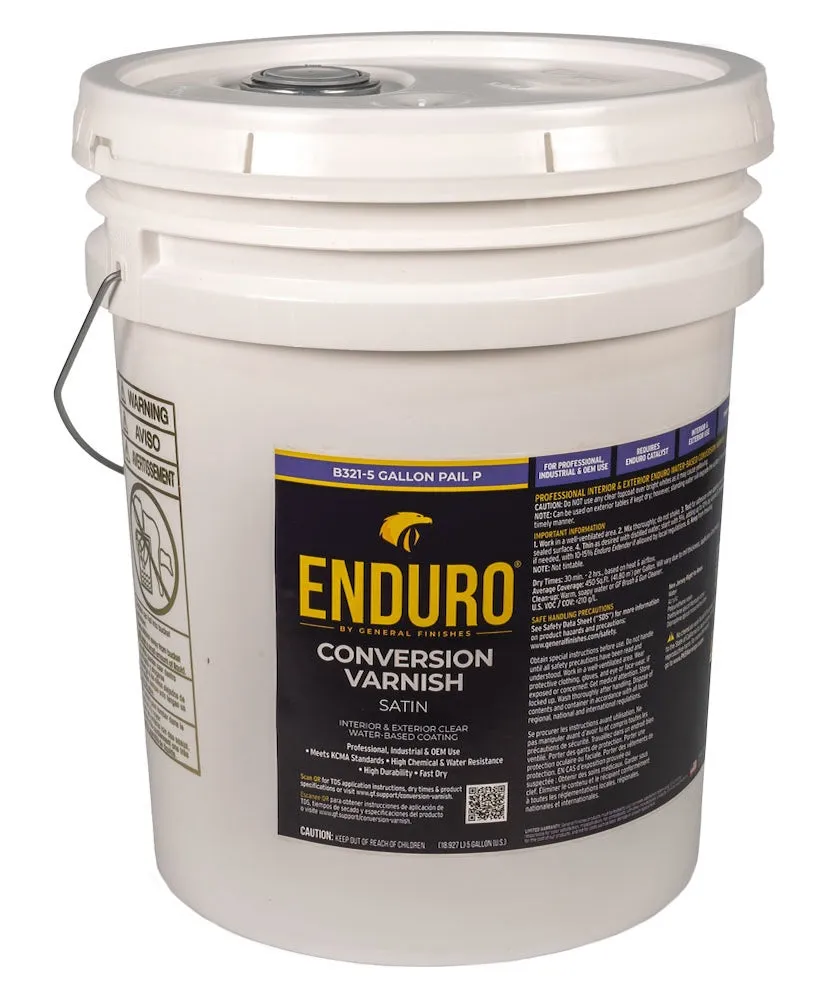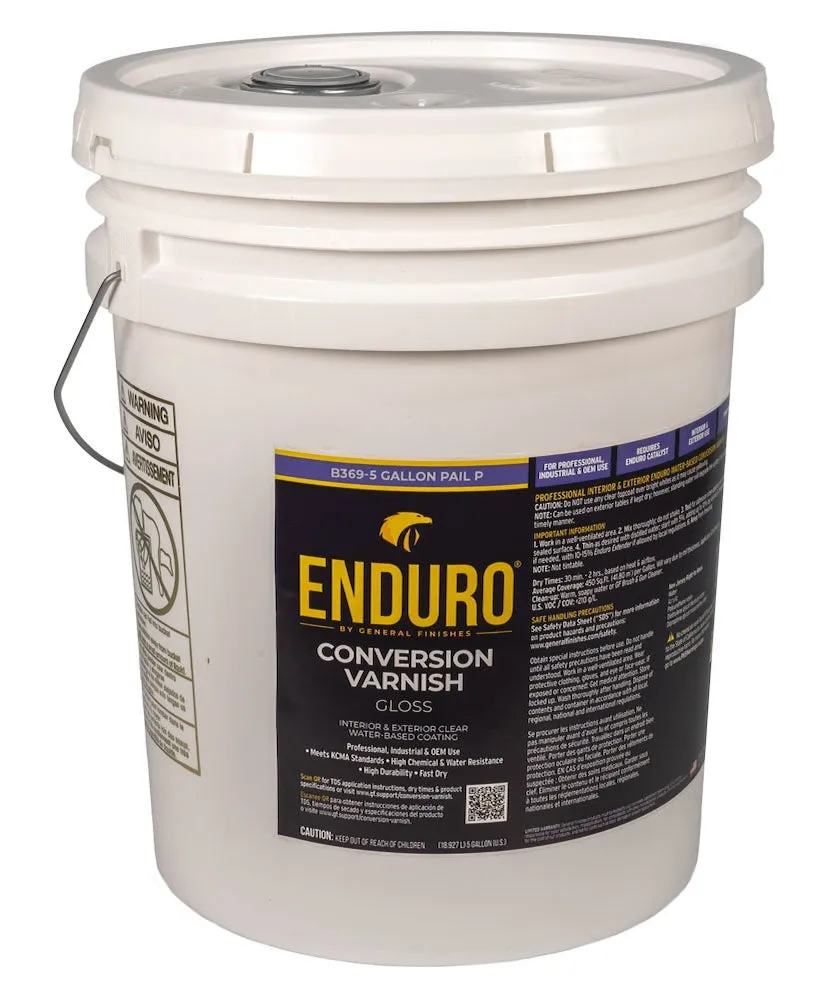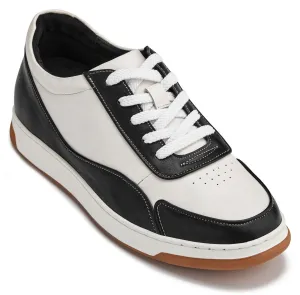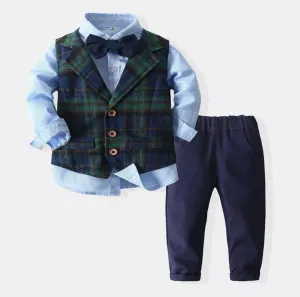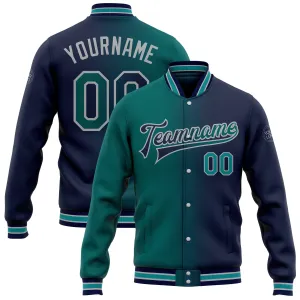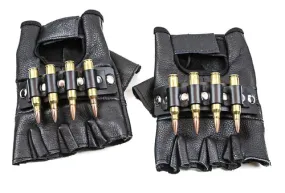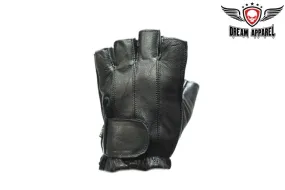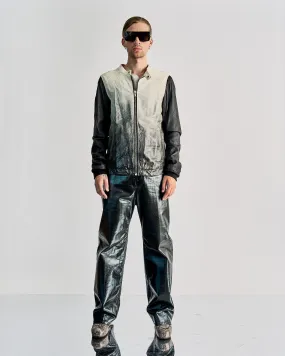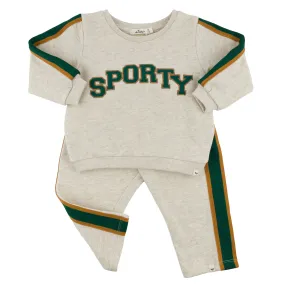General Finishes Conversion Varnish is a clear drying, two-component, post-catalyzed urethane topcoat for use when ultimate durability is necessary. Use this water-based varnish finish for high-use wood projects that receive a lot of wear, such as bars, commercial tabletops, bathroom vanities, around dishwashers, kitchen cupboards or high-moisture areas. One is included with a purchase of a gallon of Conversion Clear Coat Varnish.
Please click the below headers to reveal the instructional info for this product.
Step 1: Preparation of Conversion Varnish
All wood projects require preparation sanding, and all existing finishes require prep cleaning and sanding. If you skip this critical step, your finish may fail.
Preparation for Raw Wood or Raw Wood Projects That Are to be Stained
- Sanding Schedule: 120-grit followed by 150- or 220-grit sandpaper.
- Remove dust with a vacuum, compressed air, an oil-free tack cloth or a water-dampened rag.
- Let dry completely before applying GF product.
- Do not over-sand with fine-grit sandpapers; this will close and seal the wood grain, preventing ideal color absorption.
- Do NOT use steel wool with water-based finishes; the particles will get trapped in the finish and rust.
Preparation for Projects with an Existing Finish (Sealed Surface)
For high-use areas with heavy grime build-up and oil from hands, give your project a deeper cleaning.
- Scuff clean with a Scotch Brite™ pad and a 50:50 mix of denatured alcohol and water. Dry 1-2 hours. Avoid cleaning with products containing phosphates (salt), which can linger in the substrate and produce a white haze. If your project requires a deeper cleaning, see Power Prep Cleaning Highly Used Existing Finishes below.
- Sand lightly with a fine-grade (220-320) foam sanding pad.
- Remove dust with a vacuum, compressed air, an oil-free tack cloth or a water-dampened rag.
- Let dry completely before applying General Finishes product.
Power Prep Cleaning Highly Used Existing Finishes
For high-use areas such as kitchen cabinets or table tops with heavy grime build-up and oil from hands, give your project a "Power" clean.
- Scrub clean with a detergent, such as Spic and Span or Dawn, using a Scotch Brite™ pad.
- Rinse well with water.
- Scrub clean with a Scotch Brite™ pad and a 50:50 mix of denatured alcohol and water. Dry 1-2 hours.
- Sand lightly with a fine-grade (220-320) foam sanding pad.
- Remove dust with a vacuum, compressed air, an oil-free tack cloth or a water-dampened rag.
- Let dry completely before applying General Finishes product.
Alternative Cleaning Solutions For Existing Finishes (Not as aggressive or effective as denatured alcohol; requires rinsing.)
- 50:50 mix of bleach and water
- 50:50 mix of vinegar and water
- Mineral spirits can be used when working with water-based products, but only if the surface is thoroughly rinsed and allowed to dry for 72 hours.
- If you use with products containing phosphates (salt), which can linger in the substrate and produce a white haze, be sure to rinse thoroughly.
Step 2: How To Apply General Finishes Conversion Varnish
General Finishes Conversion Varnish is a clear drying, post-catalyzed, high-solids, two-component urethane formulated for ultimate durability and chemical resistance, and requires (one catalyst is included with a purchase of a gallon).
CAUTION: Do NOT use GF Conversion Varnish or any other clear coat, over white or light paints such as , or as it may cause yellowing. Any clear coat can become reactive over wood substrates or existing finishes causing tannin, stain or dye bleed-through. All of GF's White Paints, brushable or spray versions, do NOT require a topcoat.
Conversion Varnish Application Steps
- Stir thoroughly to reincorporate solids that have settled to the bottom of the can using a power drill and mixer (recommended) or by hand with a paint stick.
- Slowly add up to 10% by volume (3.2 oz. per quart; 12.8 oz. per gallon) to Conversion Varnish while stirring thoroughly. Allow 2-3 minutes when mixing with a power drill, or 5 minutes when mixing by hand with a paint stick. Use gloves and protective eyewear when mixing. Mix only what you are going to use and clean spray gun immediately after use. The finish can only be mixed once, and the leftover product will solidify after 6-8 hours. DO NOT store in a closed container to avoid pressure build-up.
- Thin as desired, with distilled water (before or after mixing with ); start with 5%, increase up to 10%.
- Increase open time, if needed, with up to 5% by volume of if allowed by local regulations. GF Extender can be used to improve flow and leveling, and increase open time, which is helpful in dry climates. California Residents: Adding more than 2% of GF Extender will make the product non-compliant per SCAQMD Regulations. GF assumes no liability for the improper use of these products.
- Let Conversion Varnish sit for 15 minutes.
- Apply 3 coats. For high-moisture areas, apply 4 coats. Additional coats will not improve durability.
- Spray application: Before spraying, strain topcoat through a fine-mesh filter. Spray wet films at 3-5-mil thickness. HVLP: 1.1mm-1.3mm spray tip, medium air cap. Verify tip sizes with your equipment supplier. . Keep your gun at a 90° angle, 6-8" from the surface. On large, flat areas, use wet, even patterns 6-8" wide. For narrow surfaces, reduce the fan pattern to 2-3" wide to reduce overspray. Overlap each pass 25% to conceal lines. Wear a full filter respirator (NIOSH/MSHA-approved) and work in a ventilated space.
- Face frames on cabinets: Enduro professional products are engineered to be spray-only but can be successfully applied by hand to cabinet face frames or edges with a pad applicator or small, cabinet-specific roller such as Whizz Velour brand. Larger areas may not level with a hand application.
- If a faster build is desired when applying clears over raw wood, use General Finishes Sanding Sealer for the first coat, followed by 2 coats of Enduro Conversion Varnish.
- Dry 2 hours between coats in ideal conditions: 70°F/21°C; 50% humidity. Be sure to allow adequate dry time. You can tell if a water-based finish is dry if it forms a powder when lightly sanded with a fine-grade (220-320) foam sanding pad. If in doubt, wait longer. Rushing the dry time can cause "blush," which is clouding in the finish due to moisture trapped between the layers. Increase dry time if:
- Humidity is over 80%
- 3 coats are applied
- Thick coats are applied
- Applying over an existing sealed finish
- Applying over products from other brands
- Layering General Finishes water- and oil-based products:
- Water over oil: Let oil-based products dry 72 hr before applying water-based products
- Oil over water: Let water-based products dry 24 hr before applying oil-based products
- To accelerate dry time in humid conditions, add and work in a space with good ventilation and air movement. If you decide to re-coat before the recommended time, test dryness.
- Finish sand between coats with a fine-grade (220-320) foam sanding pad to improve smoothness and adhesion.
- Remove dust with a vacuum, compressed air, an oil-free tack cloth or a water-dampened rag.
Toning
Conversion Varnish cannot be used as a toner.
Cure Time
Water-based finishes cure and harden for full use after 21 days in ideal conditions. Avoid placing heavy objects on surfaces that have not completely cured. Treat gently, and do not clean with commercial products during the curing period.
Warning: Do not use water-based products with Linseed Oils or Danish Oils.
Yellowing & Clear Topcoat
As is true of most "water-white" topcoats, General Finishes water-based topcoats dry clear over non-reactive substrates, such as plastic or metal, except , which ambers. When white paint sealed with a water-white topcoat is applied to something as unpredictable as wood, all bets are off and the reason for yellowing is often unknown. It can be caused by topcoat activating tannins in raw wood or aniline dyes, stains, or contaminants in a pre-existing finish. This is most evident when using BRIGHT WHITE paint and most prevalent in sculpted details of furniture where the topcoat can collect, intensifying color change to an unacceptable level.
There is no reliable way to predict whether yellowing will occur and to what degree. Every existing finish is different and we rarely know the finishing provenance on an existing piece. Every tree is different and every piece of wood is unique. Raw wood can bleed tannins immediately after the topcoat dries or months later with seasonal temperature changes. Oak, pine, mahogany, and douglas fir are particularly prone to bleed-through.
Summary
- Whites have a lower “hide” quality and are more transparent than most other colors. Nearly all bright whites require additional coats to achieve the desired color and minimize color variation. This can increase the cost of paint finishing. Always include a clause in your contracts addressing the need for additional coats to achieve coverage.
- All bright white paint will yellow slightly with time, with or without topcoat. You have probably tried to touch up white woodwork in your home after several years and noticed the new paint is brighter.
- The underlying finish or wood species can affect the final color of light paint.
- Details and inside corners are difficult to cover with any paint color, but it tends to be more noticeable with whites. This is a naturally occurring phenomenon in paint application and does not necessarily constitute a defect in the paint finish or your technique.
- The more porous the paint, such as a chalk paint, the more likely that yellowing will occur. The topcoat is seeping through the spaces caused by the larger particles of filler that give Chalk Paints their texture.
Tips to Prevent Yellowing
- If it is a low-use project, use a premium white paint that is self-sealing and does not require a topcoat. A clear topcoat is not required on for increased durability, as it is a self-sealing, exterior-rated coating with high durability and chemical and water resistance. However, topcoats do provide a smooth surface that is easier to clean and boosts durability for high-use projects, such as tabletops and kitchen cabinets.
- Use a professional spray such as . It has "increased topcoat properties," is a standalone finish when 3 coats are applied, and does not require sealing with a topcoat.
- We recommend using , an engineered chemical barrier, to prevent persistent bleed-through for interior-use projects.
- r does not adhere to melamine cabinet veneers.
- cannot be tinted.
- Always test your project's ENTIRE finishing schedule (from cleaning to topcoat) on an inside door or a more hidden area of the piece. This will not help if the yellowing occurs later, but at least you will know if there is an immediate problem.
- Avoid painting period furniture, such as a 1940s serpentine mahogany desk, with light colors. The pieces were often finished in stain that contained aniline dyes, which cast a pinkish bleed-through under light paint. Not every piece of furniture is suitable for upcycling with a light paint color. Pine, mahogany, and furniture of the 1940s and 50s are a red flag.
- Last, not all manufacturers' topcoats are compatible with other finishes and may react with a color change. Always follow best practices by not rushing, and testing to your satisfaction first.
Knots
Knots in wood tend to bleed and are dense, making paint and stain adhesion a challenge. may improve adhesion and prevent bleed-through for painting projects. Pine knots are especially difficult to cover with white or light paints. If you decide to paint over them, apply 3 coats of Stain Blocker first; however, we cannot guarantee adhesion or bleed-through blockage. You are better off using a dark paint on pine.
Storage of General Finishes Conversion Varnish
Life of Product
Water-based products do not last forever, even when unopened. General Finishes products are best used within 1 year of the manufacture date listed on the bottom of the can. The life of the product may be extended with proper care and storage.
Settling
Gravity can cause some solids to settle on the bottom of the can and slight separation on the top. This is normal. If working with older Conversion, use paint mixing attachment on a drill. If the solids dissolve and clumps smooth out after mixing from the bottom, the product is in good condition for use.
Storage Tips
- The finish can only be mixed once, and the leftover product will solidify after 6-8 hours.
- DO NOT store in a closed container to avoid pressure build-up.
- Store in moderate temperatures. Avoid temperatures below 50°F/10°C or above 100°F/26°C. Frozen and heat-damaged product cannot be revitalized. Temperature-controlled spaces, such as a basement, are ideal for storage. Do not store product in an attic, garage, in direct sunlight, or next to something warm like a water heater or furnace.
- Store can upside down to create a liquid seal, minimize evaporation and reduce the chance of crystallization.
Furniture Care & Maintenance
Cure First
You have just finished applying a fine furniture finish. Treat gently until the paint or topcoat have fully cured. Allow 21 days for a water-based finish to cure and 30 days for an oil-based finish to cure before cleaning.
Regular Cleaning and Maintenance
- Remove dust with a water-dampened cloth. Dust can build up over time and may scratch or dull finishes if not removed regularly.
- Remove fingerprints, cooking fumes and smoking residue with mild soap and water. These contaminants will not harm the finish, but they accumulate on surfaces and dull the original luster.
- As with all fine furniture finishes, avoid using furniture polish, cleaners or dusting sprays that contain silicone, alcohol, ammonia and anything acidic. Exception: We have successfully cleaned with Clorox wipes.
- Clean up water, alcohol and food spills in a timely manner and use placemats & coasters to protect the finish.
- Future finishes or touch-ups may not adhere properly or perform as desired over a contaminated surface. Some contaminants, such as silicone, seep through finish into the wood and often cannot be removed.
- Avoid excessive exposure to direct sunlight, high temperatures or high humidity. These can damage furniture and finishes.




